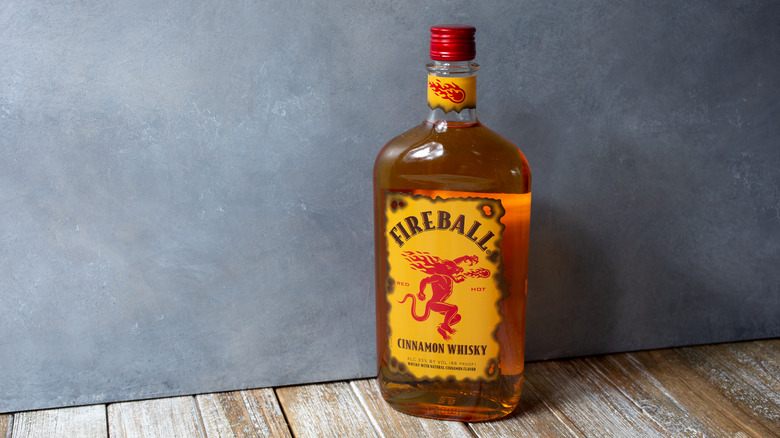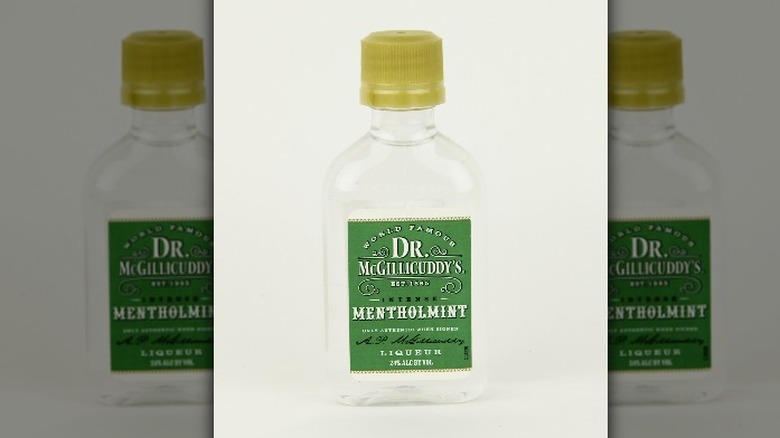The Name Fireball Whisky Used To Have
Any fan of whiskey is probably familiar with the sweet cinnamon burn of Fireball. This famous whisky is a blend of sweeteners, cinnamon flavor, and Canadian whisky, according to A Couple Cooks. The concoction first hit the market in Canada in the mid-1980s, where it became a popular way to warm up during the cold Canadian winters. While it caught on quickly in the north, it took a while for Americans to warm up to the drink when it first reached the United States a few years later, according to Bloomberg.
However, by the 2000s, Fireball was a staple at fraternity parties everywhere. In fact, Fireball Whisky was so popular that it became the best-selling liqueur in the U.S. and landed William Goldring, the chairman of Fireball's parent company Sazerac, on the list of 500 wealthiest people in the Bloomberg Billionaires Index in 2016, according to Independent Beverage Group.
Fireball delivers a slightly burning cinnamon flavor that is reminiscent of the cinnamon candy that shares the drink's name. However, while the beverage's name now is synonymous with cinnamon whiskey itself, that wasn't always the case. In fact, Fireball used to be called something else entirely, raising the question: Would a whiskey by another name burn as sweet?
Fireball was once called Dr. McGillicuddy's Fireball Cinnamon Whisky
When Fireball Whisky was first released in Canada, it was marketed under the rather wordy name: Dr. McGillicuddy's Fireball Cinnamon Whisky. Much like a shot of the stuff, the original name was a bit of a mouthful. At the time, Dr. McGillicuddy's Fireball Cinnamon Whisky was owned by the drink company Seagram, and it was just one of a lineup of flavored schnapps trumpeted by the so-called "Shot Doctor," according to Bloomberg. The fictitious Dr. McGillicuddy also put his face on other liqueurs with strong flavors like Methomint and Black Licorice.
Perhaps unsurprisingly, these somewhat unique schnapps were not exactly flying off the shelves. As a result, Seagram sold its entire line of Dr. McGillicuddy's, including Fireball Cinnamon Whisky, to Sazerac in 1989. While Black Licorice schnapps never developed a cult following, Fireball didn't do quite so hot at first, either. However, in 2007, the cinnamon whisky was spun off into its own brand, separate from the stuffy Dr. McGillicuddy, and the name was shortened to the much more succinct "Fireball." This turned out to be a smart marketing move. Sales of Fireball exploded in the 2000s, growing a whopping 3,600 percent from 2010 to 2016, per Independent Beverage Group.
The name Fireball Cinnamon Whisky is misleading
However, it turns out the original name –- Dr. McGillicuddy's Fireball Cinnamon Whisky –- was a little misleading. While Fireball is still commonly referred to as a whiskey, it actually does not meet the official definition. According to MasterClass, whiskey is made from fermented grain, which is aged in barrels or wooden casks and distilled, and has to be a minimum of 80 proof — at least 40 percent alcohol by volume (ABV).
While Canadian whisky is still a central ingredient in Fireball, altogether, it only has an ABV content of about 33%, according to A Couple Cooks. The lower alcohol content combined with the sweeteners and cinnamon flavor is part of what makes Fireball such a shootable whisky. However, technically Fireball should actually be classified as a liqueur, which is a spirit that has flavor and spices added, and has a lower alcohol content than liquor, according to Insider. So while the drink is now known as Fireball Whisky, Fireball Liqueur might be the most accurate name for this popular boozy beverage.


